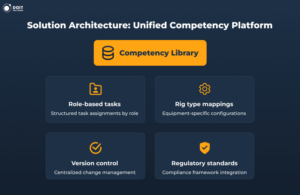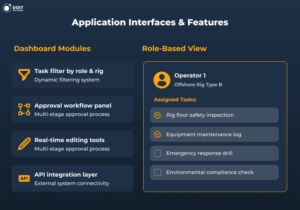Process automation is no longer just a digital trend in enterprise operations. It’s a game-changer for post-acquisition integration challenges. Thanks to process automation specialists and AI developers, companies can now build unified competency management systems that cut operational silos.
When offshore drilling contractors acquire several companies, they inherit fragmented competency systems that don’t communicate with each other. Each acquired team brings its approach to roles and compliance requirements across various rig types and regions. But how does automation solve these integration challenges?
This case study covers how process automation transforms workforce competency management systems in oil and gas mergers. You’ll learn how automation specialists standardize role-based tasks to understand practical solutions for digital transformation in oil and gas. So, let’s get started!
The multinational offshore drilling contractor faced the classic post-acquisition challenge. After acquiring several companies, they operated many disconnected competency systems that made compliance tracking nearly impossible.
The scale of their challenge becomes clear when you look at the numbers. Thousands of competency tasks lived in separate spreadsheets across various roles and rig types. Each acquisition brought new systems and conflicting task definitions.
Their immediate challenges included:
The company required a systematic approach to unify competency management. Moreover, they needed to maintain flexibility for different rig types and regional requirements.
Process automation specialists approached this challenge through a carefully orchestrated series of steps. Here’s how they transformed the fragmented system into a unified platform.
First, the post-acquisition consultants collaborated with data engineers to create a unified competency library. This central repository organizes task definitions by role, rig type, and compliance standard.

The library structure enabled several breakthrough capabilities:
The system provided different user roles to interact with the data according to their respective responsibilities and approval authorities.
Once the data foundation was solid, the development team created a web platform that managed the complexity of role-based task assignments. The application provided different interfaces for different user types and maintained data consistency.

Next, the automation team designed workflows that matched the company’s existing organizational structure. They created distinct user roles with specific permissions:
Approval workflows ensure that task changes go through proper review channels. When someone proposes a modification to a competency rule, the system routes it to the appropriate reviewers based on the task category and affected rig types. This intelligent automation in oil and gas eliminates the email chains that plagued the previous manual process.
The final implementation phase introduced AI capabilities that transformed the most labor-intensive aspects of competency management.
AI developers add significant value through intelligent task analysis. Rather than forcing human reviewers to manually compare thousands of task descriptions, AI systems can identify patterns and suggest opportunities for consolidation. This capability transforms what would be months of manual work into days of guided review.

The AI integration phase represented the culmination of the entire project. By this point, the system could manage competency data and actively improve it through intelligent analysis.
The automated competency management system delivered measurable improvements across many operational areas.
First, task definitions became consistent and compliant across all roles and platforms. It eliminated the confusion that previously plagued cross-team coordination. Additionally, audit preparation transitioned from a weeks-long process to a structured approach with readily available documentation.
Compliance officers gained real-time visibility into competency requirements across the entire organization. They could generate reports that combined data from all acquired entities. Now, it provides a comprehensive view of certification status and training needs.
The reduced administrative overhead freed up HR to focus on strategic initiatives. Now, they can develop training programs based on unified competency requirements, rather than fragmented information from different systems.
Moreover, the platform architecture has built-in future integration capabilities. When the company decides to connect the system with their enterprise tools, the structured data and API design will support these integrations without major system overhauls.
All in all, process automation has transformed how companies in complex industries handle post-acquisition integration challenges.
Automation solutions have greatly improved the competency management system, making role-task mapping more accurate and compliant across all acquired teams. Moreover, AI-powered standardization has offered better data consistency and reduced manual overhead.
Companies facing similar integration challenges should consider hiring automation engineers and AI developers early in their merger process. These specialists bring the technical expertise and strategic perspective needed to turn fragmented systems into unified platforms.
Share your requirements to connect with top process automation consultants.
Talk to expertsA competency management system standardizes the tracking of employee skills, certifications, role-based tasks, and training requirements across an organization. The system ensures that workers have the right qualifications for their roles.
In complex industries such as oil and gas, these systems manage thousands of specialized tasks across various rig types, locations, and regulatory frameworks. The platform eliminates guesswork about who can perform specific tasks and provides clear documentation for audit.
AI transforms competency management from a manual administrative burden into an intelligent system that improves over time. For example, generative AI can standardize task descriptions across different formats and writing styles. Semantic similarity detection can identify duplicate or overlapping competency requirements. Moreover, AI can automatically map tasks to regulatory standards and suggest connections between related competencies.
Automation consultants bring the technical and process expertise needed to transform fragmented competency data into a functional system. They work closely with HR, compliance, and operations teams to map real-world workflows into structured digital processes. They design approval paths and role-based access controls, build data models, and integrate them with existing platforms.
The biggest advantage is visibility. After a merger, most organizations struggle with inconsistent role definitions and duplicated tasks across teams. A centralized competency platform creates a single point of reference for all departments and teams. It standardizes safety-critical task definition and tracking and clarifies role expectations for faster onboarding.
Long-term, it supports data-driven planning by showing where skills gaps exist and which teams need additional training.










